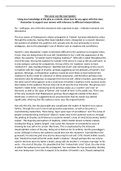‘We never see the true Hamlet.’
Using your knowledge of the play as a whole, show how far you agree with this view.
Remember to support your answer with reference to different interpretations.
No – soliloquys, one of the few characters who is genuine in play – intimate moments, not
obsequious
The true nature of Shakespeare’s titular protagonist in ‘Hamlet’ has been debated by critics
through the centuries, having often been labelled a hero, misogynist or a coward. However,
the question of whether the audience ever actually sees his true personality is no less
ambiguous, due to the playwright’s use of themes such as madness and surveillance.
Hamlet’s ‘antic disposition’ makes it extremely difficult for the audience to recognise when,
if ever, they are being shown his true self. Established in Act 1 with the appearance of the
Ghost, the question “is Hamlet mad or feigning madness?” (Worrall) is asked throughout the
rest of the play, forcing the audience to wonder if the prince is ‘mad as the sea and wind’, or
is only acting to confuse his compatriots. On top of this, his ‘madness’ seems to have
‘method in’t’, slyly insulting Polonius’ ‘plentiful lack of wit’ and commenting on the court’s
corruption with the visage of insanity, perhaps suggesting we see glimpses of Hamlet’s real
opinions. Although, an Elizabethan audience would be more likely to have believed this
madness to be the result of a demonic or divine possession, and therefore perhaps more
inclined to view his behaviour as separate from his true self. Ofelia’s reaction, upon being at
the other end of what appears to be a cruel bout of Hamlet’s madness in the nunnery scene,
also implies to the audience that we have not at all seen his true character. She grieves over
Hamlet’s ‘noble mind’, reminiscing on his previous status as a ‘courtier’ and ‘rose’ of
Denmark, as well as the ‘glass of fashion’ and ‘mould of form’ in the public eye. This is one
of the only moments that Shakespeare portrays the protagonist outside of the play’s
timeframe, in which it is suggested by his assumed lover that his nature has altered
significantly, inferring that the audience never sees the original Hamlet.
Not only this this, but the playwright also complicates the matter of Hamlet’s true nature
further, through the court’s overt and pervasive supervision, as well as the prince’s
overwhelming melancholy. There being “layer upon layer of surveillance” and “the sense of
people constantly being overheard” (Bate) is made clear to the audience early on, through
the plotting of Claudius and Polonius to examine Hamlet’s state of mind by becoming ‘lawful
espials’. This lingering atmosphere of duplicity, which Hamlet almost certainly realises,
trusting the King as ‘adders fanged’, may cause the character to constantly be wary of
showing his true self in his ‘prison’-like home. This is emphasised by the intensely
claustrophobic nature of the play, being set in Elsinore for its entirety, bar the gravediggers
scene. Although in theory the audience would then see the characters’ true identity in the
graveyard, his extreme grief may also be obscuring his real self. Critic Harold Jenkins asserts
that “Hamlet has lived all his life under death’s shadow”, though perhaps this can only be
said for the time since his father’s death, along with his mother’s ‘o’erhasty marriage’ to his
uncle – the start of the play. It is plausible that this “melancholic crisis” (Cox), the only state
in which the audience has seen the protagonist, has overtaken his true personality, thereby
not ever being seen. Even this is argued to be another of Hamlet’s acts, Woods stating that




